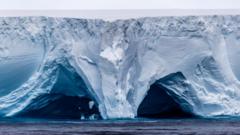A monumental iceberg, A23a, is on an impending collision path with South Georgia, a remote British territory well-known for its rich biodiversity, potentially jeopardizing local wildlife, including vulnerable seals and penguins. Currently 173 miles (280 km) away, the A23a iceberg is making its way north from Antarctica, where it could possibly ground and break apart, endangering animals reliant on the island's icy coves for feeding. Previously, large icebergs have caused significant casualties among bird and seal populations in this region.
Sea captain Simon Wallace recently expressed his concerns about the iceberg's looming threat, noting, “Icebergs are inherently dangerous. I would be extraordinarily happy if it just completely missed us.” In the meantime, scientists are closely monitoring A23a's trajectory using satellite imagery as they await both the iceberg's arrival and its effects.
This iceberg is notably one of the oldest, having fractured from the Filchner Ice Shelf in Antarctica in 1986, and was subsequently trapped for decades. Only recently, in December, it broke free from its ocean vortex and is now approaching South Georgia at an accelerated pace. The warming ocean waters from the north are eroding the iceberg’s towering cliffs, which stand at approximately 1,312 feet (400 meters).
Initially spanning roughly 3,900 square kilometers, A23a has lost considerable mass, shrinking to approximately 3,500 square kilometers, similar to the size of Cornwall, England. As it deteriorates, large chunks of ice continuously detach, potentially creating floating ice segments that could linger in the area for prolonged periods.
South Georgia and the Sandwich Islands historically face threats from such icebergs, including the A38 iceberg that grounded in 2004 and led to the death of numerous penguin chicks and seal pups. Marine ecologist Mark Belchier emphasized that as South Georgia exists in what is commonly referred to as "iceberg alley," this pattern is expected to continue.
The presence of icebergs significantly impacts both wildlife and local fisheries, urging a necessity for adaptation among both. Fishermen and sailors have reported an uptick in iceberg sightings, leading to heightened operational challenges. One such iceberg, A76, instigated alarm in 2023 due to its unexpected proximity, prompting increased vigilance among crew members.
As these ice masses become more prominent due to climate change, the incidence of similar events is likely to rise, underscoring a shifting environmental paradigm. This could herald an eventual break from stability for the ecosystems dependent on the region's glacial structures, prompting scientists to prepare for the changes ahead.
Despite the looming dangers, the iceberg's presence offers a unique opportunity for scientific inquiry. Researchers aboard the Sir David Attenborough recently situated themselves near A23a, allowing them to examine how melting icebergs influence local ecosystems. PhD researcher Laura Taylor emphasized the iceberg's significance for understanding the carbon cycle in the Southern Ocean, noting the release of nutrient-rich meltwater that could ultimately aid in sequestering carbon from the atmosphere.
As A23a nears, the environmental community remains on high alert, aiming to navigate the complexities of our rapidly changing climate and its effects on Earth's icy frontiers.

















